Bull and terrier
The bull and terrier (often hyphenated as bull-and-terrier) is an extinct type of dog.[2][3] It was a crossbreed that was the progenitor of several modern standardised breeds (Bull-type terriers), including the Bull Terrier, Miniature Bull Terrier, Staffordshire Bull Terrier, American Pit Bull Terrier, and American Staffordshire Terrier. Bull and terriers were crossbred primarily from the Old English Bulldog and one or more varieties of Old English Terriers.[4][5][6][7][1]
| Bull and terrier | |
|---|---|
 Bull and terrier | |
| Other names | Half-and-half, fighting bull terrier, bull-terrier,[1] Canis pugilis[1] |
| Origin | Britain |
| Foundation stock | Old English Bulldog Old English Terrier Whippet |
| Breed status | Extinct. Not recognized as a breed by any major kennel club. |
| Notes | Progenitor of: Bull Terrier, Miniature Bull Terrier, Staffordshire Bull Terrier, American Pit Bull Terrier, and American Staffordshire Terrier |
| Dog (domestic dog) | |
Names
Over the years, this type of dog received diverse names, including bull and terrier, half-and-half, half-bred, pit dog, bulldog terrier, and pit bulldog.
The most popular name for some time was bull-terrier, a name later applied to the standardised breed created by James Hinks in the later half of the 19th century (the Bull Terrier). Many paintings, texts and engravings during or prior to this period named the bull-and-terrier only as "bull-terrier", generating confusion with the Hinks' breed. However, the two dogs can be differentiated considering the fact that the Hinks's breed only began to be popularized in the last two decades of the 19th century, and that there were only white Hinks dogs, with a distinctive elongated head shape and triangular eyes, until the beginning part of the 20th century.[8] The term pit bull terrier was sometimes applied, though later also used a modern standardised breed.
Some historical bull-and-terrier paintings are today mis-identified as Staffordshire Bull Terriers, but the breeds are differentiated by the latter being the descendant of the Cradley Heath variety only, and therefore not representative the bull-and-terrier type more generally.
History
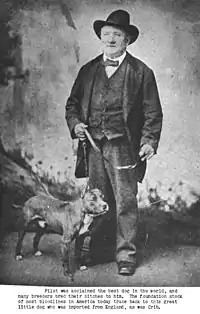
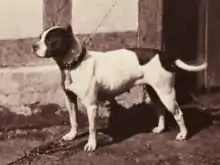
(Paris, 1863)
There were several varieties of this combination between bulldog and terrier, depending on the location (town or country) and the dogs chosen for the crossing. In Ireland, they used the old Irish bulldog with different terriers and some insertion of hunting sighthound/terrier crosses.[9] In England, there were several varieties such as the Walsall type and the Cradley Heath type.[9] Phil Drabble reported that among the various types of bull and terrier, the type from Cradley Heath was recognised as a separate breed to be named the Staffordshire Bull Terrier.[9] In the 19th century, the Walsall type was carried by immigrants to the United States, where it served as an important component for the genetic basis of the American Pit Bull Terrier breed, through specimens such as the dog Lloyd's Pilot[10] and the Colby bloodline, strongly combined with Irish strains.[9][11] The anatomy of the bull and terrier is the result of selective breeding for the purpose of hunting,[12] dog fighting, and baiting.
Hunting
Most terriers, of the past and present, carried or carry a quarter to an eighth Old English Bulldog ancestry,[12] for their purported courage to bear the bites of badgers[13] and other prey they are meant to corner, dig for, or attack. Terriers that were not developed from crosses between the Old English Bulldog and earth-working dogs were of inferior quality and were valued far less.[12]
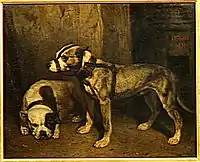
There are earth-working dogs who by default and definition are called terriers because they have the ability to go to ground; however, the best earth-working and hunting terriers were regarded as the progeny of bulldogs bred to earth-working dogs (terriers), with the offspring known as bull-terriers or half-bred dogs, among other names.[12][14]
John Henry Walsh wrote in The Dog, in Health and Disease, by Stonehenge (1859):
The terrier as used for hunting is a strong useful little dog, with great endurance and courage, and with nearly as good a nose as the Beagle or Harrier. From his superior courage when crossed with the Bulldog, as most vermin-terriers are, he has generally been kept for killing vermin whose bite would deter the Spaniel or the Beagle, but would only render the terrier more determined in his pursuit of them.
Walsh also wrote of the Fox Terrier (or, rather, of its cross-breed ancestor): "The field fox-terrier, used for bolting the fox when gone to ground, was of this breed [bull and terrier]."
Not only is the Fox Terrier the progeny of the bull-and-terrier,[15] but so is the Airedale Terrier,[16] rat-working terriers, working black and tan terriers, and most all other vermin-hunting terriers.[12][14]
James Rodwell described in his book titled The Rat: Its History and Destructive Nature, that the great object, among the various breeders of bull-and-terrier dogs for hunting vermin and rats, was to have them as nearly thorough-bred bull as possible, but at the same time preserving all the outward appearances of the terrier as to size, shape, and colour.
Dog fighting
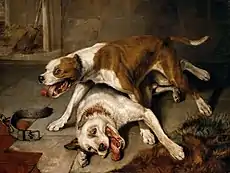
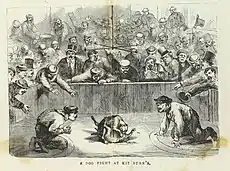
The Old English Bulldog was bred for bull-baiting. Its life depended on a fighting tactic of "go low, pin, and hold". Such a breed was unsuitable for dog fighting in the "pit". Once an Old English Bulldog got a good grip, there would be little left for the spectators to see, except for two dogs gripping each other, closing their jaws tighter and tighter.
Required were quick attacks, new grips, and tricks, which made up the drama of a dog fight that appealed to spectators, gamblers, and dog owners. The introduction of English Terrier blood provided longer legs, fiery temperament, and speed, which provided entertaining fights.
The crossing of bulldog and terrier produced a dog that no longer belonged entirely to either foundation stock. With attributes such as ferociousness, aggressiveness, and intelligence, there were few fighting tasks a bull-and-terrier could not perform better than other breeds of those times.
In 1835, with the banning of baiting, the breed was placed in jeopardy of extinction; however, while bull-baiting and bear-baiting laws were enforced, dog fighting flourished, so the bull-and-terrier lived on. Around 1860, the type split into two branches, increasingly standardised over time into distinct breeds: the pure white Bull Terrier, and the coloured forms that lived on for another 70 years in the dog pit until they finally were recognized as a legitimate dog breed called the Staffordshire Bull Terrier.[4] Around the same time, many lower-class Irish and Englishmen were emigrating to America with their terrier–bulldog crossbreeds, including from both of those developing bloodlines. Over time, the descendants of these dogs became taller and heavier. Their masters opted for a dog that was both an aggressive warrior in the gambling dens of the cities and saloons but also was a working dog, its terrier and bulldog blood from Ireland and the UK proving to be very useful in farm work and in hunting. The breed was officially recognized as the American Pit Bull Terrier in 1898 and later its close kin the American Staffordshire Terrier in 1936.
Famous bull and terriers
According to accounts in Sporting Magazine from the year 1804, a bull and terrier named Trusty (owned by Thomas Pitt, 2nd Baron Camelford[18]) was just as famous throughout England as the Emperor Napoleon. Trusty went undefeated in 104 dog fights. In 1812, Sporting Magazine described another a famous and talented dog, Dustman, as representing the optimal bull-and-terrier type.[13]
"DUSTMAN is a celebrated dog, the property of Wm. Disney, Esq. and of a breed between a bull and a terrier, the best of any to attack that formidable animal, the badger. The breed of dogs of this description, has been much encourage of late, and held in great estimation, as being more staunch than the terrier, and not too powerful for the badger."[13]
— Rogerson & Tuxford, Sporting Magazine, 40 volume, 1812.[13]
A celebrated bull and terrier named Billy, weighing approximately 26 pounds, set a world record for rat-baiting on April 22, 1823, by killing 100 rats in five-and-a-half minutes.
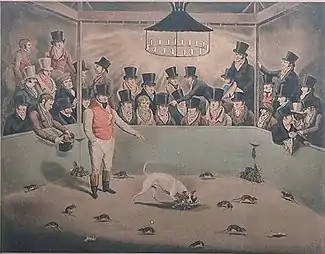 Billy
Billy Dustman
Dustman.jpg.webp) Trusty
Trusty
See also
References
| Wikimedia Commons has media related to Bull and Terrier. |
- Maxwell, William Hamilton (1833). The Field Book: Or, Sports and Pastimes of the United Kingdom; p. 81
- Gibson, Bethany (10 January 2012). Bull Terrier. i5 Publishing. ISBN 978-1-59378-969-5.
- Klerk, Dr Joanna de (22 July 2019). The Complete Guide to Staffordshire Bull Terriers: Finding, Training, Feeding, Caring for, and Loving your new Staffie. LP Media Inc.
- Fleig, D. (1996). Fighting Dog Breeds. T.F.H. Publications. ISBN 0-7938-0499-X
- Shaw, Vero (1879–1881). The Classic Encyclopedia of the Dog. ISBN 0-517-43282-X
- Brown, Thomas (1829). Biographical Sketches and Authentic Anecdotes of Dogs
- Burton, William Evans; Poe, Edgar Allan (1839). The Gentleman's Magazine
- The Bull Terrier: A Complete Anthology of the Dog. Read Books Ltd. 2013. ISBN 978-1-4474-9182-8.
- Drabble, Phil (1948). "Staffordshire Bull Terrier". In Vesey-Fitzgerald, Brian (ed.). The Book of the Dog. Los Angeles: Borden Publishing Co. p. 669. Retrieved 2 February 2018 – via Stafford Exchange.
- Harris, David (24 July 2012). The Bully Breeds. i5 Publishing. p. 22. ISBN 978-1-62187-032-6.
- Colby, Joseph L. (29 March 2011). "Colby's Pincher". The American Pit Bull Terrier (History of Fighting Dogs Series). Read Books Ltd. ISBN 978-1-4465-4887-5.
- Walsh, John Henry (1959). The Dog, in Health and Disease, by Stonehenge
- "Dustman, an Engraving". Sporting Magazine. Rogerson & Tuxford. June 1812. p. 97. Retrieved 17 June 2019 – via Google Books.
- Wood, John. The Illustrated Natural History
- Meyrick, John. House Dogs and Sporting Dogs, Their Variety ...
- Dickens, Charles. All the Year Round: A Weekly Journal
- Ormond, Richard; Rishel, Joseph; Hamlyn, Robin (1981). Iandola Watkins, Jane (ed.). Sir Edwin Landseer. New York / London: Philadelphia Museum of Art and Rizzoli Libri / Tate Gallery and Thames & Hudson. p. 5. ISBN 0-8478-0390-2 – via Internet Archive.
- "Lord Camelford: Gentleman Thug (Part One)". View from the Mirror. 7 June 2018. Retrieved 17 July 2019.